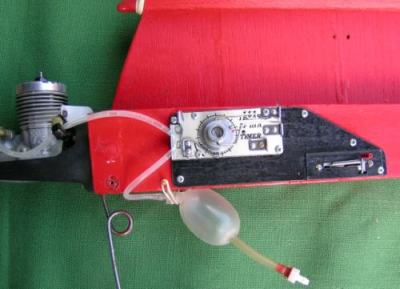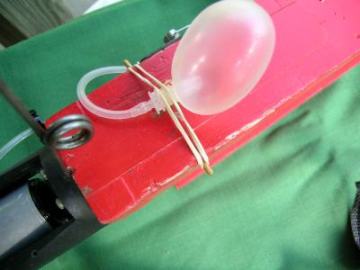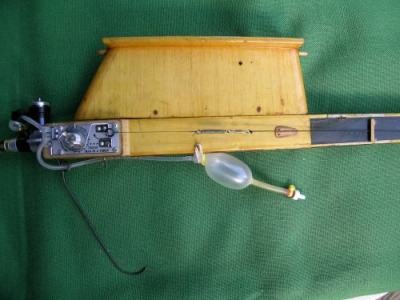BASIC PRESSURE BLADDER INFORMATION
OVERVIEW
We use pressure feed to our competition free flight engines to
better regulate the flow of fuel under the strong accelerations our planes have
when going up. Without a pressure feed (i.e. suction), the engine will have a
tendency to starve for fuel and will have a surging jerky climb. This will
reduce the altitude we reach. Note: for fun or sport flying where the engine and
plane combination does not climb like a rocket, suction is fine and a lot
simpler.
There are two types of fuel pressure used in FF. One uses crankcase pressure fed
to a hard sided tank. This pulsing pressure will add some "push" to the fuel and
aid it in getting to the engine. It is pretty simple to do, and is fairly easy
to do as well as not messy like using bladder feed. But, it does not give the
same forced feed of a bladder and is not commonly used. There is one problem
that does show up when trying to stop the engine. With the line between the
crankcase and the fuel tank, fuel can be sucked back into the crankcase on the
piston up cycle and this can make the engine sputter when you are trying to stop
it by fuel starvation with pinchoff. In these cases, a one-way valve needs to be
added to the crankcase/fuel tank line. A device like our check valve is commonly
used.
Most competition flyers use some sort of bladder to force feed
fuel to the engine. In the past, pen bladders and pacifiers were routinely used,
but these items are scarce today. More common is the use of a thin-walled latex
or neoprene tubing which is inflated with fuel using a syringe. (see below how
for to
make these bladders)
STARTING AN ENGINE ON BLADDER PRESSURE
Under bladder pressure, the fuel comes out like a fire hose.
The way to start an engine is to have the needle pre set. You almost never touch it,
other than maybe a tiny tweak depending on the weather or fuel.
You put the battery on the plug, pinch the fuel line with your finger, release
the clamp you have on the fuel line, get the starter in hand, give the fuel
line a short blip to prime the engine, and hit it with the starter. The engine
should fire immediately, and as it gets going good, release your finger on the
fuel line. Be ready to pinch it if the engine is loading up.
For the initial needle setting on a new engine, I close off the needle
totally. and crack the needle enough to let fuel start to drip out of the
line. I watch for the initial bubbles to start to flow in the line, and stop
the flow by pinching off the line when the fuel reaches the engine inlet. This
will get you in the ball park, on the lean side. With experience, you can tell
by the sound if it is rich or lean. There is a fine difference between rich
and lean needle
settings. It is better to be lean than rich as you can flood it real fast.
Best if you do all this fussing around on a bench rather than in the plane.
When you have the needle setting where the engine screams, leave it alone.
Then put it in a plane and go fly. You may have to give it a tiny tweak, but
that is it.
I used to start .40 size engines by hand, but no more. I stand behind the
plane with the starter on a stooge and push the engine into the starter. I did
hand start a .19 a couple weeks ago for a neighbor kid who could not get it to
run. But, it was in a waist high engine test mount so it was firm and I could
back away fast.
MAKING PRESSURE BLADDERS
The tubing will expand like a fat hot dog or Polish sausage. One
end of the tubing can be tied with a knot, or a one-way check valve can be used.
The advantage of the valve is it allows fuel to be added without removing the
fuel line from the engine and opening up the timer. Care needs to be taken to
avoid losing the rather costly valve in the event of a bladder rupture. Yes,
they frequently burst. The other end of the tubing is mated with a fitting to
match up to the fuel line. The tubing will expand first from the end that is
stretched over the fitting and "grow" rearwards as more fuel is added. The
longer the tubing, the greater the amount of fuel. You will be surprised how
much fuel will go into a short length of tubing. The tubing will yield a
pressure that is quite constant all the way down to nearly empty. Yes, we sell
all of these items.
Sometimes the bladder is suspended below the plane and other
times, it is put inside the fuselage where an epoxy sealed cavity has been
built. This is mostly the flyer's choice or preference. The way I do it on most
planes is shown in the photo below. I put a dowel through the fuselage and a
piece of 1/64 ply under the fuselage. Then string a rubber band back and forth
between the dowel ends, trapping the bladder fitting under it. This is very
secure, and yet easy to replace. Ideally, the bladder is at the CG location so
fuel load does not upset the the flight characteristics, but this is not always
feasible. For purposes of the photos, I used air in the bladders, but they fill
up the same with fuel.






